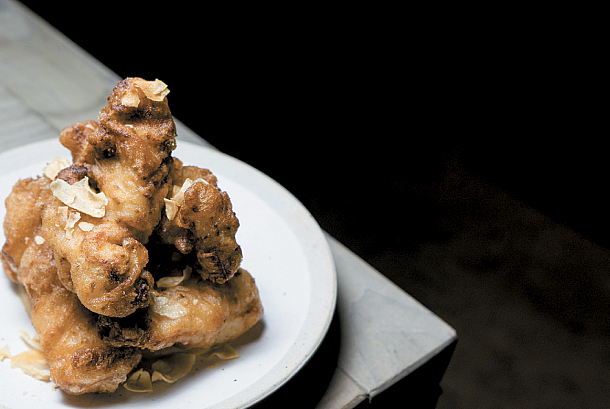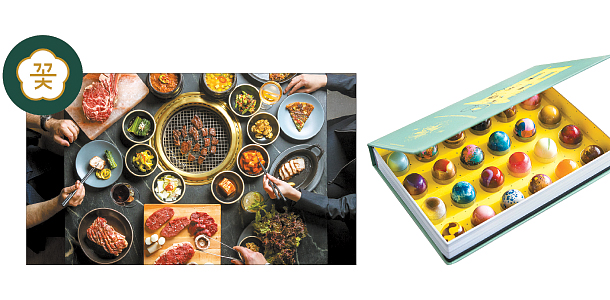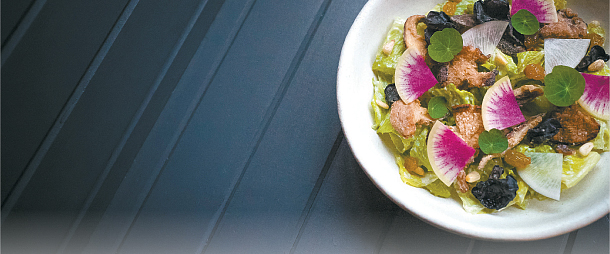Definition of hansik expands in America : U.S.-based chefs push Korean cuisine in tasty new directions

Fried chicken, now known as a major Korean food, is also served at Atoboy with added garlic on top and peanut butter sauce on the bottom. [ATOBOY]
Chef Junghyun Park of Atoboy works with chef Lee Choong-hoo of Zero Complex, who has done collaboration dinners in Seoul with globally known chefs from Le Chateaubriand and Le Galopin in Paris. The joined forces of rising stars in Seoul and New York gather those who love to try out the marriage of what’s American, Korean and French to a restaurant a few blocks away from Madison Square Park.
“Although what we are doing isn’t completely Korean, I wanted to take on a challenge and show what we Koreans can do and only Koreans can do, whether it’s about flavors or aesthetic plating,” said Lee adding that this is a chance for him to taste the water in the United States after focusing on trends in Europe over the past few years, and see if he wants to seek out more opportunities in the future. Lee’s first official cooking session in the U.S. will be a seven-course meal served to 90 people who are each paying $90 for the meal. “I will be using French cooking techniques but the flavors will come from my memory of Korean food from my youth, such as some doenjang jjigae (soybean paste soup) with a hint of an herbal smell.”
This collaboration is one example that Koreatowns in major U.S. cities are not the only destinations for quality Korean food these days, as young Korean chefs try to diverge from what already exists and show what their own version of “authentic” Korean food is in a more refined setting. Their versions may seem more modern in terms of aesthetics, but the use of fermented sauces are all there in a more approachable form in order to show that Korean ingredients can be adaptable.
“To show not only people in the U.S., but also globally, the diversity that comes with Korean cuisine and chefs, we have decided to invite chefs in Korea to the U.S. so that we can create new things to present at Atoboy,” said Ellia Park, reiterating the importance of exchanges of knowledge and experience between chefs.
Many young Korean and Korean American chefs and service experts who studied in culinary schools or worked in renowned upscale restaurants in the U.S. jump into the food scene in New York and other cities by opening their own restaurants that serve modern food inspired by Korean cuisine and flavors. Thanks to these passionate professionals wanting to make it work in cities like New York, Los Angeles and San Francisco, hansik, or Korean food, as well as the Korean chefs behind it, have become a magnet for attention and affection from local food aficionados.
Atoboy has been around for less than a year. To differentiate itself from already existing so-called modern Korean restaurants like Jungsik, Hanjan, Danji or Oiji, it has decided to highlight what’s been underappreciated in New York: banchan, the side dishes that usually come for free when served with rice and soup. Chef Park challenged himself to convince diners that Atoboy’s banchan is worth paying for, and has shown that the form and meaning of classic hansik can continuously change.
“It requires effort from lots of people to try to find the definition of what makes hansik, and as I run a restaurant in New York, I have experienced in person that what appeals to New York diners has changed a lot,” said Ellia Park, manager of the restaurant and wife of the executive chef Park, adding that people who only used to know about bulgogi or Korean barbecue now look for Korean dishes they have not yet tried. The couple expanded their ideas to offer New Yorkers a chance to discover more Korean chefs through its “Korea Chef Series.”

A new upscale Korean barbecue restaurant called Cote, left, opened in Flatiron earlier this month. Stick with Me, a chocolate shop by Korean-American Susanna Yoon puts its bonbons in a decorative box. [COTE, STICK WITH ME]
The ambience at Cote, which sounds similar to the Korean word for flower, isn’t what many expect a Korean barbecue restaurant to look like. You still grill your meat at your table like most Korean barbecue restaurants, but in a much fancier setting where you won’t get covered with the smell of smoke. No need to worry about not knowing what to order, as the restaurant offers a butcher’s feast option which comes with beef, banchan and rice or noodle dishes to end the meal for $45 a person.
“Primitive yet refined, how sexy is that?” said Kim, the owner. “I wanted to create a space where we can celebrate life in Korean ways and show that it is awesome. A place Korean Americans would feel proud of and a place where non-Koreans would feel comfortable and exited about.
“It’s time for a Korean flower to blossom in NYC.”
It even has a bar, a new concept for a Korean barbecue place to have, but quite normal for any American style restaurant. The ambience of the restaurant is no different from any other higher-end spot serving American food, Kim said. More than 600 different wines and specialty cocktails are available for those wanting to match their Korean food to Western-style drinks alongside soju, including Hwayo from Korea and Tokki from New York. Why make the interior more American? Kim said it is his attempt to make the place comfortable so that stronger Korean flavors with fermented sauces won’t seem too foreign to diners.
“I wanted to create a place where you get a non-westernized version of Korean barbecue experience,” said Kim. “I spent years thinking about how to not touch the authenticity of the food but make everything else very local and comfortable with hint of very high refinement, like Korean antiques for those [who do not have much experience with Korean food.]”
The Cote owner has been bold about not making compromises with Korean flavors.
“[Local diners] have such a thick skin that soft touches do not penetrate easily. You have to punch them hard to get them to listen to you,” Kim said. “Nothing is ever new in New York City, so stick to your intuition, your core, and people then will be likely to respond to your message.”

Seasonal mushroom salad with pine nut dressing served at Oiji in East Village. [OIJI]
“If you were to do hansik because you think you feel the responsibility to make hansik widespread here, I don’t think the restaurant would work out well,” said Kim. “One needs to [have] a business mindset and then maybe the satisfaction [of having] promoted Korean food will come later when you actually achieve something.”
To make the restaurant viable, the two decided to take small steps first. Although they can’t bring what’s popular at the moment in Korea to New York and expect locals to like them, they try with small things that may work. In the past years when honey-butter-flavored potato chip were a craze in Korea, the chefs thought that flavor may work in New York as well, and made their own version of the potato chips for New York diners to try.
“The definition of hansik comes from how localized the flavors are, and what we feel is hansik will be what locals know as hansik, so chefs in New York are the ones who provide cultural experiences,” said Ku.
While there are people who do Korean food, there are Korean talents who focus on baking or chocolate. Chef Won Jong-hun of La Tabaterie, a bakery located in New Jersey, makes baguettes and other breads, and Susanna Yoon makes chocolate bonbons in NoLita at Stick With Me. Jin Ahn who used to work for Per Se recently opened Noreetuh, a place that serves Hawaiian food.
The idea of getting out of Koreatown and opening a restaurant has been in practice since the opening of Jungsik in New York in 2011, a sister restaurant of Jung Sik Dang in Seoul. The Michelin-two-starred New York branch has been a hot spot for many aspiring chefs fresh out of culinary school as they want to not only practice their cooking skills but also to learn the business of opening a restaurant. Atoboy’s chef Junghyun Park worked as a Chef de Cuisine at Jungsik, Won Jong-hun of La Tabatiere was the Executive Pastry Chef, and Jin Ahn of Noreetuh also worked as General Manager.
“It is neither that I expect more talents to come to Jungsik nor am worried that [some will only come for the title],” said owner Yim Jung-sik of Jungsik in New York.
“Since there are many young chefs joining the restaurant now, I am considering directing in a different way, [away from cooking in the kitchen,] so that I can invest more into youngsters.”

Top is a dish served at Baroo in Los Angeles, which is inspired by temple cuisine and uses many different fermentation techniques. Above is a raw meat dish served at Atoboy in New York. [BAROO, MATTY YANGWOO KIM]
Outside of big name Michelin-three-starred restaurants like Benu in the Bay Area, smaller spots like Baroo in Los Angeles have been garnering attention from local diners. Featured in Bon Appetit magazine’s 2016 list of America’s Best New Restaurants, and loved by food critic Jonathan Gold of the Los Angeles Times, the restaurant has found success serving unique combinations of ingredients. The use of nuruk, a type of mold used to ferment food and beverages in Korea, and the jars of different ingredients on the wall inside the restaurant take their inspiration from temple cuisine, which has received international attention after Jeongkwan Sunim, a Buddhist chef, was featured on the third season of the Netflix documentary series Chef’s Table.
Despite the attention and stellar reviews, chef Kwang Uh has not stopped refining his skills. He went to Baekyang Temple where Jeongkwan Sunim lives and works and stayed about six months to learn more from the fermentation and vegetable expert and find a culinary direction he wants to go in future.
“I never thought I would do what I do at Baroo for a long time, so I needed to take some time to review if what I have done is aligned with what I want to do in the future,” said Uh.
Even some sommeliers are making their way to the United States to explore the different dining scenes. Shin Dong-hyuk, who used to work at Jung Sik Bar in Seoul and the2016 Korea Sommelier of the Year, will soon move to northern California to work and learn more about the local restaurant scene.
As many Koreans are finding success in restaurant-heavy American cities, some young Korean students have had access to international talents and have become inspired to make a career in the food business.
“Being in New York connects me to many renowned chefs and global events,” said Matty Yangwoo Kim, who just graduated from New York University Stern School of Business. Kim, a part-time contributor to food magazine Eater NY. He has recently joined book publisher Phaidon to make a cookbook for New York restaurant Contra.
“I want to experience the high level gastronomic scene and then use the things I learned in New York to bring up the level of the food scene in Korea.”
BY LEE SUN-MIN [summerlee@joongang.co.kr]










with the Korea JoongAng Daily
To write comments, please log in to one of the accounts.
Standards Board Policy (0/250자)